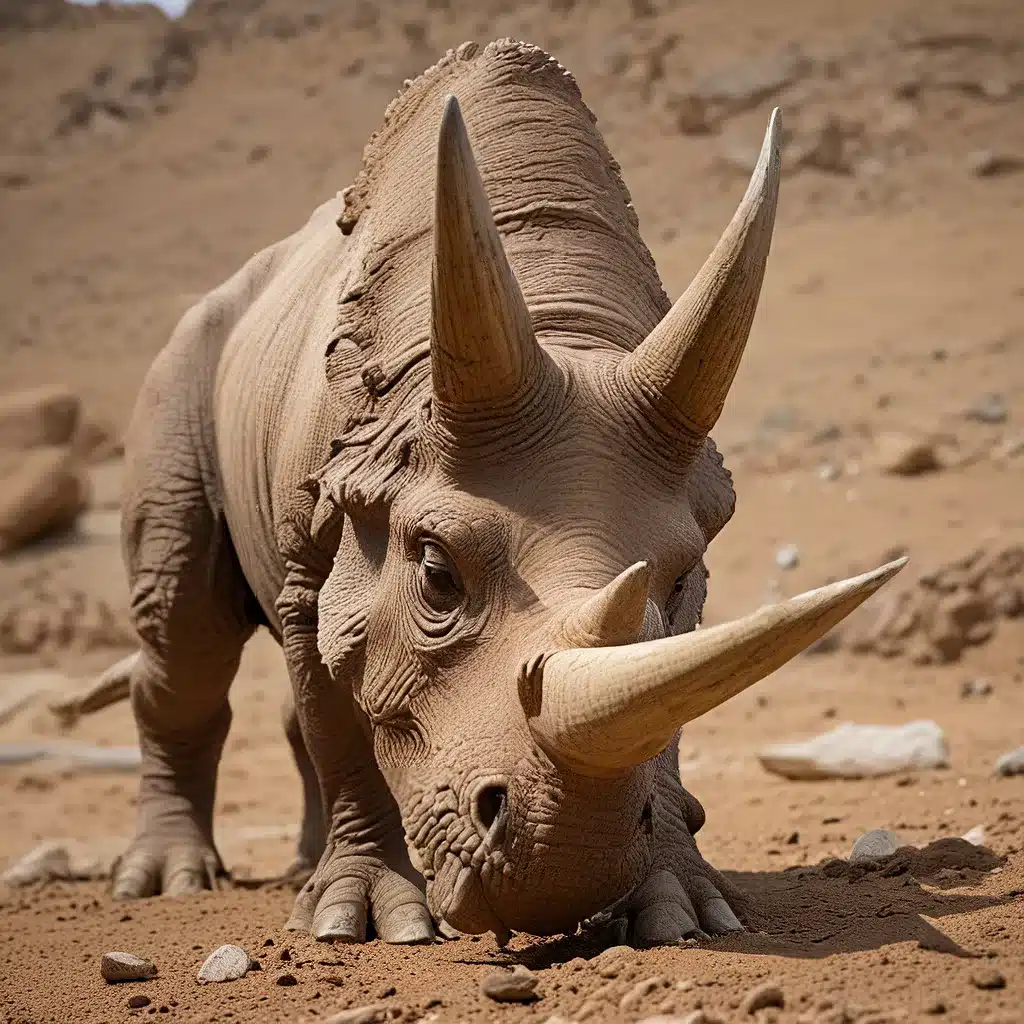
Decoding the Enigmatic Horns of Ceratopsians
The Ceratopsians, a captivating group of herbivorous dinosaurs, have long captured the imagination of paleontologists, archaeologists, and the general public alike. These prehistoric giants, often recognized by their distinctive horns and frills, have left an indelible mark on our understanding of the Cretaceous period, shedding light on the intricate dynamics of ancient ecosystems and the evolutionary adaptations that allowed these creatures to thrive.
At the forefront of this fascination stands the iconic Triceratops, a genus of ceratopsid that has become synonymous with the term “horned dinosaur.” The three prominent horns adorning its skull, alongside the formidable frill, have made Triceratops one of the most recognizable and beloved dinosaurs in popular culture. However, the true significance of these anatomical features extends far beyond their aesthetic appeal, as they hold the key to unveiling the secrets of these remarkable creatures.
The Evolutionary Significance of Ceratopsian Horns
The horns and frills of ceratopsians, like Triceratops, are believed to have evolved through a complex interplay of natural and sexual selection. These striking features likely served a variety of purposes, from defense against predators to species recognition and even social signaling within their respective herds.
The evolution of these structures has been the subject of extensive research, with paleontologists continuously refining our understanding of their functional and symbolic roles. Tyrannosaurus Rex, the formidable predator of the Late Cretaceous, is believed to have posed a significant threat to ceratopsians, making their horns and frills vital for protection and survival.
Moreover, the intricate patterns and variations observed in the horns and frills of different ceratopsian species suggest that these features may have also played a crucial role in social interactions and mating rituals. The frill, for instance, often featured bony projections known as epoccipitals, which may have been used for species recognition or as a means of display during courtship.
Unlocking the Mysteries of Triceratops Horns
The study of Triceratops horns, in particular, has been the subject of ongoing scientific inquiry, with researchers delving deep into the anatomical and physiological aspects of these remarkable structures. The discovery of Regaliceratops peterhewsi, a close relative of Triceratops, has further expanded our understanding of the diversity and evolutionary adaptations within the ceratopsian family.
One intriguing aspect of Triceratops horns is their potential use in social and mating behaviors. Researchers have proposed that the horns may have served as visual signals, allowing individuals to communicate and establish dominance hierarchies within their herds. The size and orientation of the horns may have also played a role in courtship displays, as larger and more prominently positioned horns could have been indicators of an individual’s fitness and reproductive potential.
Triceratops Horns and Their Defensive Capabilities
In addition to their social and reproductive significance, the horns of Triceratops were also formidable defensive weapons. These robust structures, in conjunction with the animal’s massive skull and powerful neck muscles, made Triceratops a formidable opponent for even the most fearsome predators of the Late Cretaceous.
Emerging research suggests that Triceratops may have utilized its horns in a variety of defensive strategies, from charging and ramming to more nuanced displays of aggression. The ability to pivot its head rapidly, combined with the sheer size and weight of its skull, allowed Triceratops to deliver devastating blows to potential threats.
Ceratopsian Fossils and the Bone Wars
The wealth of ceratopsian fossils, particularly those belonging to Triceratops, has been instrumental in shaping our understanding of these ancient creatures. The late 19th century, often referred to as the “golden era” of dinosaur discovery in North America, saw a fierce rivalry between two pioneering paleontologists: Othniel Charles Marsh and Edward Drinker Cope.
Their intense competition, dubbed the “Bone Wars,” led to a flurry of fossil excavations and discoveries, including numerous ceratopsian specimens. The work of Marsh and Cope laid the foundation for future researchers, such as Fielding Bradford Meek and John Bell Hatcher, who continued to refine our knowledge of ceratopsian anatomy, behavior, and evolutionary history.
Today, the Hell Creek Formation in Montana and other fossil-rich regions of the Western United States remain hotbeds of ceratopsian exploration, yielding new insights into the lives and times of these remarkable dinosaurs. Each new discovery adds to the growing understanding of how Triceratops and its kin adapted to their environment, interacted with other species, and ultimately met their demise during the mass extinction event that marked the end of the Cretaceous period.
The Cultural Impact of Triceratops
Beyond the scientific realm, the Triceratops has become an enduring icon in popular culture, capturing the imagination of people worldwide. From its frequent appearances in blockbuster films, such as the Jurassic Park franchise, to its prominent role in children’s books and educational materials, the three-horned dinosaur has become a symbol of the wonder and fascination surrounding prehistoric life.
This cultural significance is a testament to the lasting appeal of Triceratops and the broader ceratopsian family. Their distinctive features, combined with their formidable presence in the Late Cretaceous ecosystem, have made them a beloved subject in art, literature, and educational resources, inspiring countless individuals to delve deeper into the mysteries of the ancient world.
Conclusion: Unraveling the Secrets of Triceratops Horns
As our understanding of Triceratops and its ceratopsian brethren continues to evolve, the intrigue surrounding the function and significance of their iconic horns remains a captivating area of study. Through ongoing archaeological excavations, advanced scientific analysis, and innovative interpretations, researchers are steadily unraveling the secrets of these remarkable structures, shedding light on the complex lives and behaviors of these prehistoric giants.
The journey of discovery is far from over, and with each new finding, the world of dinosaur paleontology and archaeology grows richer, inspiring the curiosity and wonder of people across the globe. As we continue to delve into the mysteries of Triceratops and other ceratopsians, we are not only uncovering the secrets of the past but also shaping our understanding of the extraordinary diversity and resilience of life on Earth.


